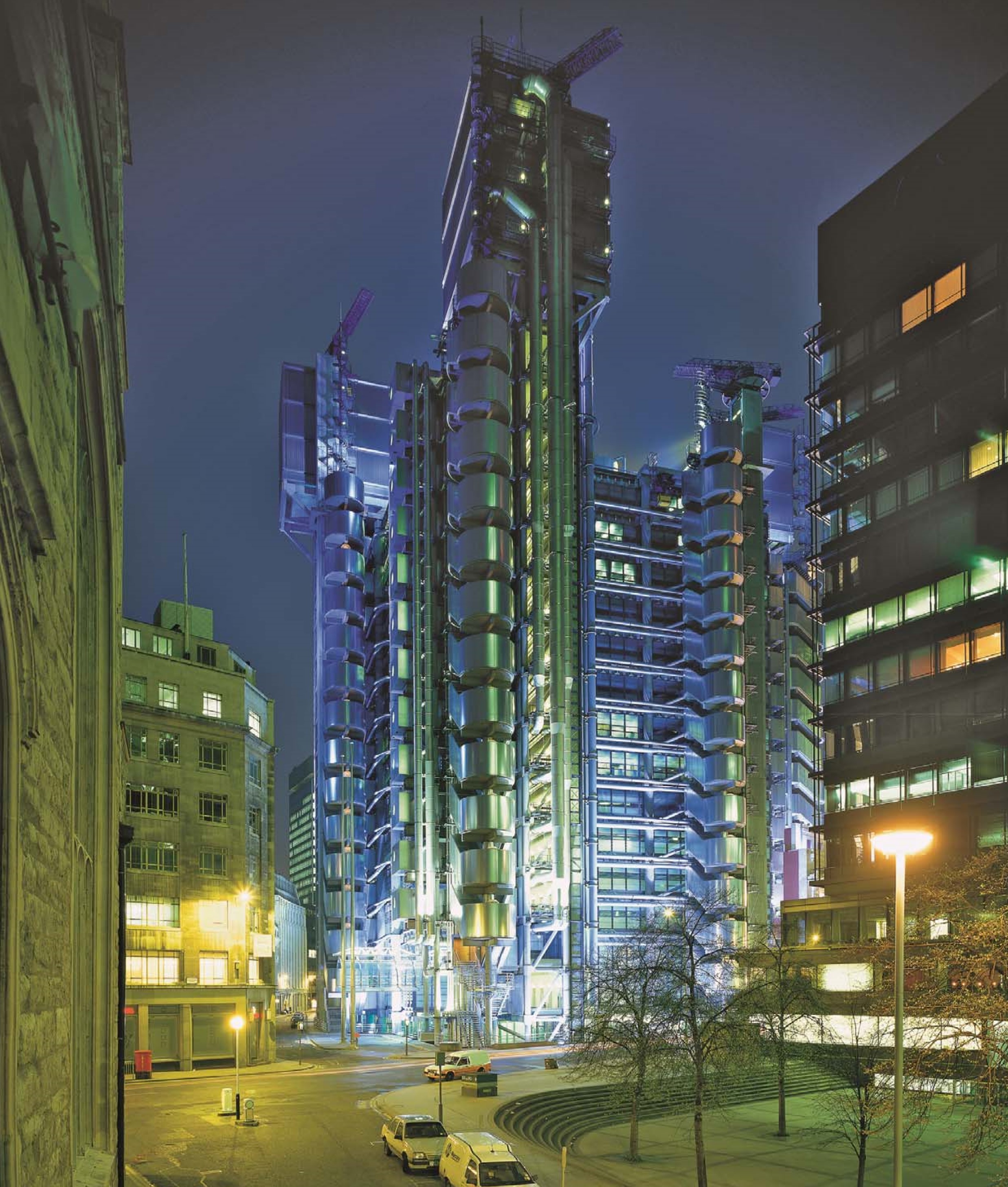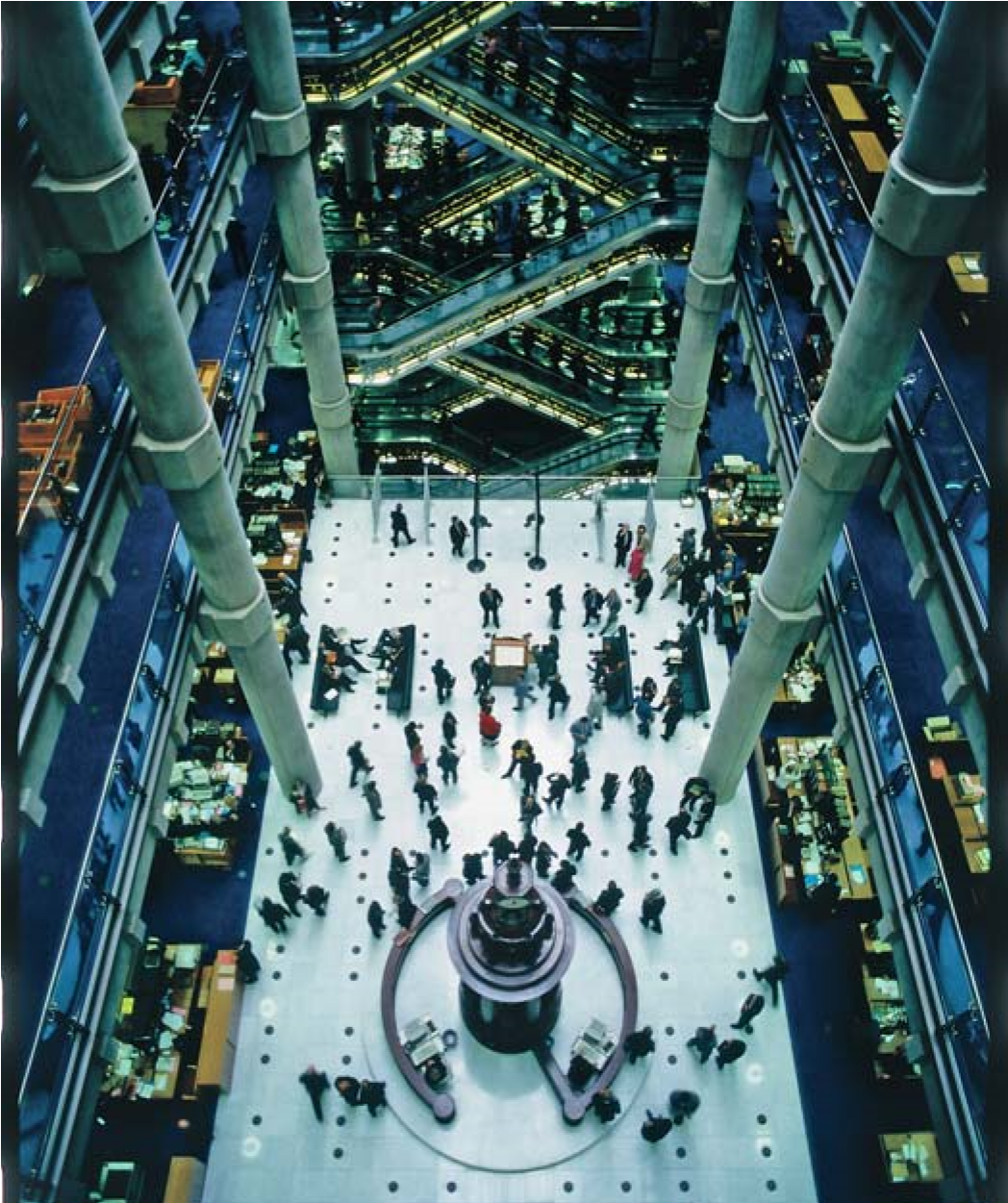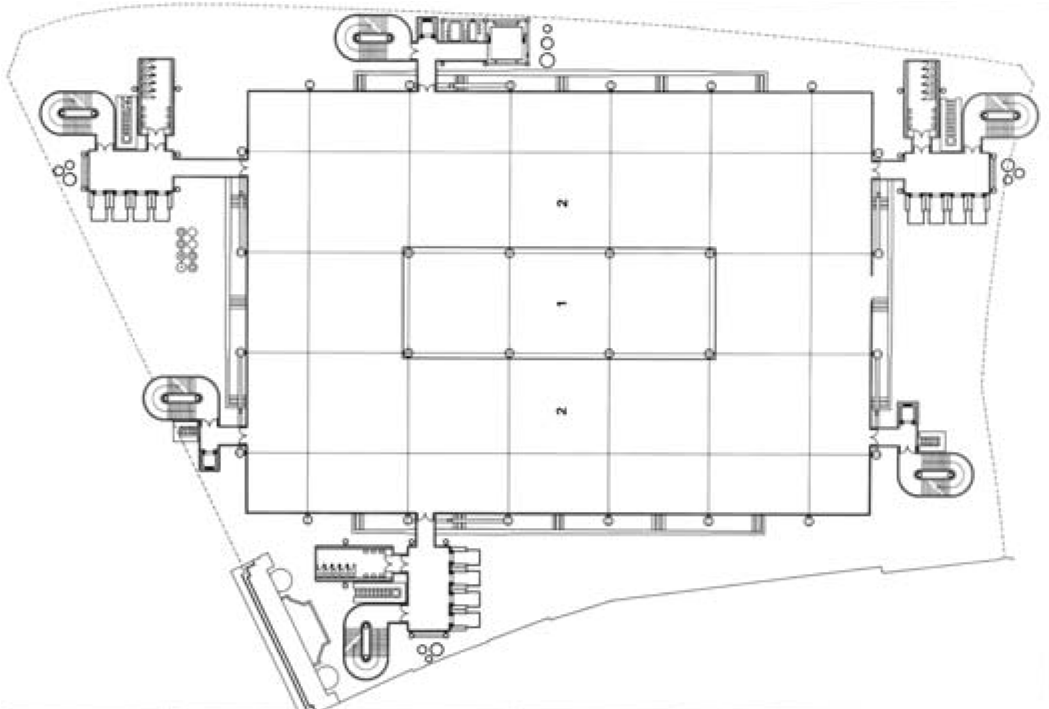Lloyd's of London
Contents |
[edit] Introduction
Lloyd’s of London, designed by Richard Rogers, is one of the most iconic buildings in London and a leading example of the ‘high-tech’ architectural style that combines both industrial and futuristic aesthetics. Historic England described it as being ‘universally recognised as one of the key buildings of the modern epoch.’
Situated at 1 Lime Street in the City of London, the Lloyd’s Building, home to insurance company Lloyd’s of London, was officially opened in 1986 after a construction period of 8 years. It cost approximately £75,000,000 to build.
[edit] History
Lloyd’s of London had occupied a nearby site on Leadenhall Street since 1928, moving to Lime Street in 1958 as a means of expanding with the market. Towards the end of the 1970s there was a need to expand further and so the decision was taken to purchase the current site.
At this time, Norman Foster and Richard Rogers were celebrated figures of British architecture, and had stated their intentions to re-energise the Modern Movement with what became known as ‘high tech’ due to its abundance of steel and glass. Public money was in short supply for the kind of flagship building projects they had in mind, so increasingly they looked to the private sector.
One of the pioneering examples of the high tech style was the Centre Pompidou in Paris, which had been designed by Richard Rogers and Renzo Piano. This building was unique in that the services, such as staircases, lifts, drainage and water pipes, were on external display as opposed to being concealed and taking up space inside the building.
When Lloyd’s commissioned Richard Rogers to design their new building, the brief was to create something that would be flexible and hence facilitate their changing needs. They also wanted a building that would provide for its needs well into the next century. It was also imperative that they could continue their operations unhindered during the rebuilding operation, which involved the demolition of the existing 1928 building. The competition for a new building was won on the basis not of an architectural proposal but of a strategy for the future of this key City institution.
[edit] Design
Richard Rogers Partnership (RRP, now Rogers Stirk Harbour + Partners RSHP) proposed a building in which the dealing room could expand or contract according to the needs of the market, by means of a series of galleries around a central space. To maximise space, services were banished to the perimeter. As the architectural form of the building evolved, particular attention was paid to its impact on the surrounding area, especially the listed 19th century Leadenhall Market. As a result, Lloyd’s became a complex grouping of towers, almost Gothic in feeling – an effect enhanced by the height of the external plant-room towers.
The building consists of three towers, each with their own service tower, which surround a central 60-metre high atrium that houses the main Underwriting Room and is naturally lit by a barrel-vaulted glass roof that took its inspiration from Joseph Paxman’s Crystal Palace. The building features 12 glass lifts that were the first of their kind in the UK.
As with the Centre Pompidou, the services were located externally, freeing up the interior of the building so that it could remain flexible, each floor capable of being altered by the addition or removal of partitions. This style was dubbed ‘bowellism’, based on the idea that the greatest amount of free floor space should be maintained.
Criss-crossing the atrium are a series of escalators intended to create a sense of the circulation between the floors. The cranes were left on top of the building, much the same as for old cathedrals that were intended to be modified and built to an ever grander scale.
When it was completed by the contractor in 1986 it stood at 88 metres (289 ft) to the roof, and contained 14 floors. With the cranes the overall height reaches 95.1 metres (312 ft).
[edit] Today
Whilst initially provoking controversy due to its striking contrast with the surrounding area, Lloyd’s is today seen as one of the great architectural achievements of the 1980s, one of the buildings which confirmed the Rogers' position in the front rank of international architects. In 2011, it became the youngest building ever to receive Grade I listed status.
It has emerged as one of the greatest modern British buildings, one which balances technical efficiency with architectural expressiveness to produce an effect that is highly-romantic and judged a very positive addition to the London skyline.
In July 2013, it was sold to the Chinese company Ping An Insurance for a reported £260 million.
It is normally closed to the public, but does open occasionally for tours, most commonly during the annual Open House London event.
[edit] Project information
- Place: London, UK
- Date: 1978 - 1986
- Client: Lloyd’s of London
- Cost: £75 million
- Area: 55,000 m²
- Structural and Services Engineer: Ove Arup & Partners
- Quantity Surveyor: Monk Dunstone Associates
- Lighting Consultant: Friedrich Wagner of Lichttechnische Planung
- Main Contractor: Bovis Construction Ltd
- Architect: Richard Rogers Partnership
[edit] Awards:
2011
- Grade I listed by English Heritage
1988
- RIBA Regional Award
- PA Award for Innovation in Building Design and Construction
- Eternit 8th International Prize for Architecture (Special Mention)
1987
- Financial Times ‘Architecture at Work’ Award
- Civic Trust Award
- Concrete Society Commendation
[edit] Related articles on Designing Buildings Wiki
- 7 Engineering Wonders of the world.
- 9 of the world’s most impressive structures.
- Bank of China Tower.
- BBVA Bancomer headquarters.
- BT Tower.
- Building of the week series.
- Centre Building at LSE shortlisted for RIBA award.
- City Hall, London.
- Fuji TV Building, Tokyo.
- Guggenheim Museum, Bilbao.
- Habitat 67.
- Leadenhall building.
- One Park Taipei.
- Metabolism.
- Millennium Dome.
- NatWest Tower.
- Richard Rogers.
- Skyfarm.
- Tallest buildings in the world.
- The Gherkin.
- The Shard.
[edit] External references
- Lloyd's - The Lloyd's Building
- RSHP - Job sheet
Featured articles and news
One of the most impressive Victorian architects. Book review.
RTPI leader to become new CIOB Chief Executive Officer
Dr Victoria Hills MRTPI, FICE to take over after Caroline Gumble’s departure.
Social and affordable housing, a long term plan for delivery
The “Delivering a Decade of Renewal for Social and Affordable Housing” strategy sets out future path.
A change to adoptive architecture
Effects of global weather warming on architectural detailing, material choice and human interaction.
The proposed publicly owned and backed subsidiary of Homes England, to facilitate new homes.
How big is the problem and what can we do to mitigate the effects?
Overheating guidance and tools for building designers
A number of cool guides to help with the heat.
The UK's Modern Industrial Strategy: A 10 year plan
Previous consultation criticism, current key elements and general support with some persisting reservations.
Building Safety Regulator reforms
New roles, new staff and a new fast track service pave the way for a single construction regulator.
Architectural Technologist CPDs and Communications
CIAT CPD… and how you can do it!
Cooling centres and cool spaces
Managing extreme heat in cities by directing the public to places for heat stress relief and water sources.
Winter gardens: A brief history and warm variations
Extending the season with glass in different forms and terms.
Restoring Great Yarmouth's Winter Gardens
Transforming one of the least sustainable constructions imaginable.
Construction Skills Mission Board launch sector drive
Newly formed government and industry collaboration set strategy for recruiting an additional 100,000 construction workers a year.
New Architects Code comes into effect in September 2025
ARB Architects Code of Conduct and Practice available with ongoing consultation regarding guidance.
Welsh Skills Body (Medr) launches ambitious plan
The new skills body brings together funding and regulation of tertiary education and research for the devolved nation.
Paul Gandy FCIOB announced as next CIOB President
Former Tilbury Douglas CEO takes helm.

























